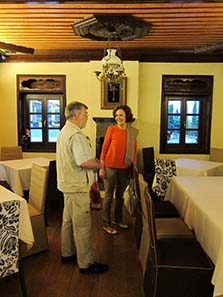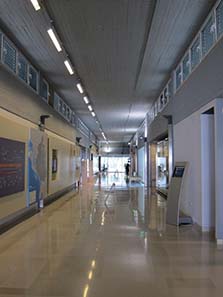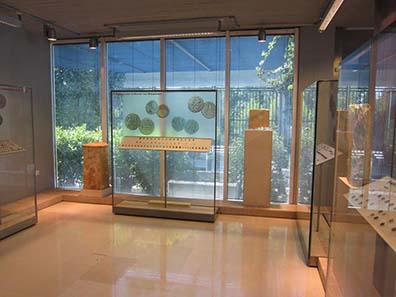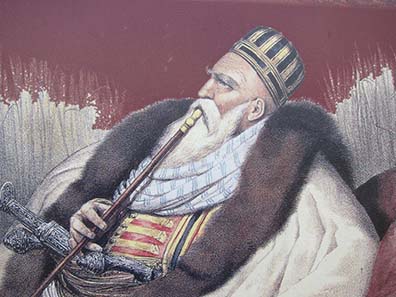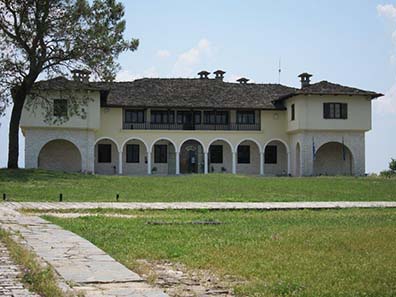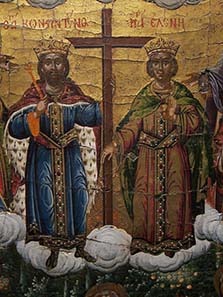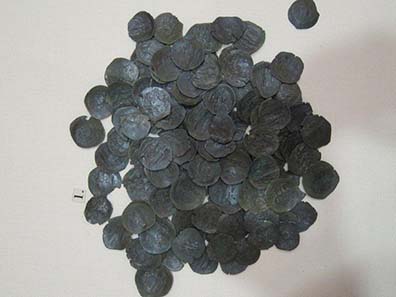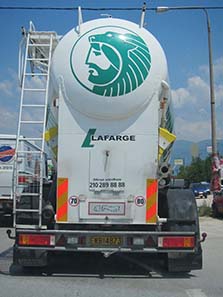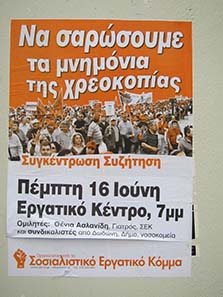by Ursula Kampmann
July 7, 2011 – During her third stage of the journey throughout Greece, Ursula Kampmann visits Ioannina where she meets numismatist Katerini Liampi. The local museum is richly equipped with coins. Great mosques refer to the Ottoman heritage, the Kastro to the “Mohammedan Napoleon”…
Day 7, June 16, 2011, We visit Katerini Liampi in Ioannina
Today we leave hospitable Parga and go up country to Ioannina. The city is the center of present-day Epirus with its population of approximately 100,000. And there are additional 20,000 or so students reading in 17 different departments of the University of Ioannina which was founded in 1970. Hence, it should be easy to find quarters in Ioannina. Quite the opposite is true. All hotels hide from us. We even drive around the entire lake Ioannina is situated at but not a chance. Everything is closed or doesn’t exist at all. Finally, after more than one and a half hours, we come across a hotel. No question, we stop and take a room. And we are lucky! By chance, we have arrived at a very well-maintained, particularly well-situated hotel. And, of course, when strolling through the city, we come across any number of hotels…
The Galaxy Hotel is something special. Not only that we receive very polite treatment (I am handed back my ID card even before we paid the bill). Despite its rather modern-looking exterior the house is decorated Epirote style including much wood and carving. When entering the lift one already notices the first beats of the syrtos from Alexis Sorbas. We start singing even before we get into the lift, when we just stand in front of it or even take the steps – that’s for sure.
Prof Dr Katerini Liampi, distinguished expert namely on Northern Greece numismatics and head of Department of History and Archaeology at the University of Ioannina, couldn’t be with us at once. She had to attend her monthly session, which means today and tomorrow. All staff members of her department meet there, at least 40 people, trying to reach a consensus on all pending issues which can become difficult. The meeting takes roughly four hours on Thursday, and on Friday, poor Katerini has to “sit” for another nine hours or so. In the homeland of democracy the negotiations are as lengthy as it takes to make all parties tired and agreed.
Katerini Liampi shows us a gorgeous restaurant aloft Ioannina, Epirote-style. Photograph: UK.
Consequently, it is half past eight when we finally meet Katerini. By taxi we get to a marvelous restaurant aloft the city of Ioannina. It interior decoration comes from several old houses of Epirus that had been torn down.
Under well-informed guidance, we learn that Greek cuisine is not merely Moussaka, Tzaziki and Ouzo. We were amazed about the typical Epirote aperitive. It is called Raki just like the Turkish Ouzo variant but doesn’t taste like any of these two. As typical appetizer we are served excellent pita bread, filled with spinach and several local herbs, plus pastry filled with different kinds of cheese and – particularly delicious – a smoked, baked cheese.
After this exorbitant entrée we tried to order something a little bit smaller as main course. No way, the two aubergines filled with mince meat were quite substantial! And after that, as is customary in Greece, a little (not ordered) desert is being served!
Good thing was that, thanks to our interesting conversation, we had no time at all thinking about how many calories too many we had taken in. Katerini Liampi tells us that in Ioannina roughly 300 students each year start reading Classics. Later, they can specialize in archeology, history, philology or numismatics.
Ioannina is an absolute center of numismatics. Katerini Liampi is contacted once intriguing coins show up in a Greek archaeological excavation. And of course she provides us with a detailed daily plan what to visit the following day. That plan, however, is so extensive that it would rather take three to four days for us to do the program.
Day 8, June 17, 2011, The city of Yannina’s lion
We are simply not used to the Greek timing yet. For one thing, the Western European Time is exactly one hour behind the Eastern European Time Greek as well adheres to. And a dinner that doesn’t start until half past eight simply takes time. In short, we were determined to get up early that day but it was already 9 a.m. when we started breakfast. The hotel, however, was startled about our desire. Although the Galaxy in fact did offer breakfast at 6 Euros each, apparently virtually no tourist had ever availed himself of that service. Hence, we witnessed a frenzy of activity upon our entering the breakfast room. Finally, the hall porter indeed found a chambermaid who, after considerable time, got us a helleniko and a tea, a huge slice of sweet cake for each of us as well as three pieces of rusk and two tiny helpings of jam. (To anticipate the result: much to the calming of the staff, we didn’t have breakfast there the next day…)
The Archaeological Museum of Ioannina. Photograph: KW.
Firstly, we arrived at the Archaeological Museum where Katerini had already announced our coming to the effect that we were warmly welcomed, were given the magnificent catalog on the special exhibition about Alexander the Great, equipped with material from Alpha Bank, and, in addition, a museum’s catalog containing marvelous pictures of the fantastic objects Ioannina houses.
The interior of the museum of Ioannina. Photograph: KW.
The museum of Ioannina is clearly worth visiting, not only because it was built by Greek architect Aris Konstantinides. The most important finds from the big excavations in Epirus are housed here. All those oracle tablets from Dodona – here they can be viewed. Apart from that, grave inventories and, of course, the material from the excavation of the Nekromanteion are to be found here.
An entire room devoted to numismatics. Photograph: KW.
Then, one becomes aware of the fact that in Ioannina Katerini Liampi is sitting, a numismatic expert of high caliber – an entire room of the museum is devoted to coins. There is a showcase with coins from all Epirus mints – and names show up that even a long-term numismatist has never heard of. Another showcase is reserved for coin finds and treasure finds. Something can be learned about the coinage of the Epirote League and, not to forget, there are another two showcases in the museum: one with images of the deities worshipped in Epirus, the other on the Molossian rulers.
In the Archaeological Museum of Ioannina numismatics surely doesn’t play minor walk-ons. Hence, when you have the chance to come to Ioannina don’t hesitate to visit the Archaeological Museum. If you are fluent in Greek don’t miss clicking here for a visit to the museum’s website. For those who never learnt that language there are still pictures of the most beautiful objects of the house to be viewed.
Fetiye Mosque with the tomb of Ali Pasha in front of it. Photograph: KW.
Katerini recommended a visit to the Kastro, Ioannina’s Old Town. You see, the city is one of the very few in Greece where the Ottoman heritage is as much cared for as the Greek. Two important mosques are situated here which were in use until the 1920s.
When talking about the Kastro one name shows up time and again – that of Ali Pasha, whom most Europeans only recall as set piece of the novel “The Count of Monte Christo”. Do you remember? Dumas had Fernand Mondego promise to take care of Ali Pasha’s wife and daughter. Instead of doing so, he sold the two into slavery after Ali Pasha had died. The Count of Monte Christo detects Haydée, the daughter of Pasha, to use her in his vendetta against the traitor.
Ali Pasha, Lion of Yannina. Photograph: KW.
Ali Pasha or Tepelene Pasha (*1740) stemmed from a powerful Albanian clan. His father was murdered by a hostile tribe when juvenile Ali was only 14 years of age. The family lost possessions and power, and Ali’s mother became leader of a robber band. Ali Pasha adapted quickly. He turned into a robber chief that attracted the attention of the Ottoman administration. The Sublime Porte took him into its service, first to wipe out the marauding bandits by official order; later, Ali’s troops were brought into action on any number of focal points in Ottoman Greece.
Ali Pasha ascended the career ladder. Finally, in 1788, he scored a big coup: he seized the city of Ioannina and built his own, independent empire there. “Mohammedan Napoleon” or “Lion of Yannina”, as he was called in the West, formed an alliance with anyone as long as he derived a benefit from it. In 1809, Lord Byron visited the former Albanian robber ruler and wrote with admiration that he was “superior in wealth, refinement and learning receptivity”. In his private letters the philhellenic wasn’t that guardedly. He criticized Ali Pasha for his cruelty and conjectured about the big harem where men and women waited for the Pasha’s desires.
In 1820, Mehmet II ordered the Sublime Porte to be restored and the power of Ali Pasha to be put to an end. The Lord of Ioannina managed to withstand two years, but, finally, in 1822, Ottoman troops took his last resort on an island in the lake of Ioannina. On February 5, 1822, Ali Pasha was shot, aged 80, and his head was sent to the Sultan in Constantinople.
He was buried next to the Fethiye Mosque in the Kastro of Ioannina, still a major tourist attraction. The lattice that spans the tomb was reconstructed following old models only a few years ago.
The Byzantine Museum of Ioannina. Photograph: KW.
Next to Ali Pasha’s tomb the Byzantine Museum of Ioannina is situated which any admirer of Byzantine art should visit.
Detail from an icon with a depiction of the Last Judgement: Constantine and Helena. Photograph: KW.
Not only marvelous icons can be found there…
Treasure find in the Byzantine Museum of Ioannina. Photograph: KW.
…but any number of coins and, most of all, treasure finds.
Treasure find with Spanish coins and a Polish one. Photograph: KW.
Especially interesting in regard to the circulation of money is a treasure find from the 17th century including 10 Spanish and one Polish coin.
The Silver Museum. Photograph: KW.
Part of the Byzantine Museum is the Treasure House which houses silver objects the silversmiths of Ioannina were renowned for. They had founded their own guild which guaranteed their goods’ consistent quality.
Belt edging; part of female attire from 1856. Photograph: KW.
Originally, the objects belonged to Archbishop Spyridon and a private collector called Ioannidis. They came as gifts into the possession of the museum.
Company nameplate of a Greek bank. Photograph: KW.
And here are some additional impressions from the streets of Ioannina. Naturally, the nameplate of Ate-Bank caught our eye whose logo shows on its obverse a coin of the Delphic Amphictyony.
Rear of a transport trolley for concrete. Photograph: KW.
And we always took pleasure in the head of Herakles, whether we saw it on a truck or on huge silos.
Poster: call to protests against the government (?). Photograph: KW.
Whereas international media of course reported in detail about the current situation in Greece, there was hardly any reflection of the violent protests, which obviously characterize the Athenian streetscape, to be witnessed in Ioannina. The only thing pointing in that direction was this poster.
We had to turn on the German news to get informed about the Greek Minister of Finance being replaced.
In a pub near the lake of Ioannina. To the left: Ursula Kampmann; to the right: Katerini Liampi. Photograph: KW.
In the evening, Katerini Liampi invited us to one of the favorite locations of Ioannina students. The lakeside promenade has dozens of pubs to sit comfortably and philosophize about life. These pubs are part of students’ life although at times it seems difficult to accommodate these with the daily life of a student. Katerini talks about students complaining because they were supposed to be in their lecture at 9 a. m. although they’d much more sleep in after going for a the night out until 4 a. m. … And so we said good-bye to Katerini Liampi and Ioannina that, thanks to Katerini’s incredible hospitality, had become even more charming that it already had been.
Accompany us next week to the power center of the Macedonian kings and guess with us where Aigai is situated after all…
You can read all other parts of this diary here.



